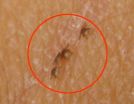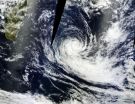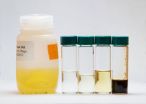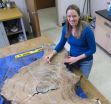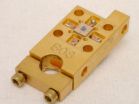(Press-News.org) In a first-of-its-kind study for Lyme disease, researchers have used live, disease-free ticks to see if Lyme disease bacteria can be detected in people who continue to experience symptoms such as fatigue or arthritis after completing antibiotic therapy. The technique, called xenodiagnosis, attempts to find evidence of a disease-causing microbe indirectly, through use of the natural disease-carrier—in this case, ticks. It was well tolerated by the volunteers, but investigators could not find evidence of Lyme disease bacteria in most of the cases where enough ticks were collected to make testing possible.
Larger studies are needed, the scientists say, to determine the significance of positive xenodiagnosis results in cases where Lyme disease symptoms persist following antibiotic therapy.
Adriana Marques, M.D., of the National Institute of Allergy and Infectious Diseases (NIAID), part of the National Institutes of Health, and Linden Hu, M.D., of Tufts Medical Center, Boston, led the pilot study. Findings appear online in Clinical Infectious Diseases.
The most common tick-borne illness in the United States, Lyme disease is caused by Borrelia burgdorferi bacteria that are transmitted to people by ticks of the Ixodes genus.
"Most cases of Lyme disease are cured by antibiotics, but some patients continue to experience symptoms despite the absence of detectable Lyme bacteria," said NIAID Director Anthony S. Fauci, M.D. "This poses a mystery that requires continued research into new or improved ways to diagnose Lyme disease and determine the cause of unresolved symptoms."
"Xenodiagnosis using ticks to detect B. burgdorferi has been used previously in animal studies, but this is the first time it has been tried in people," said Dr. Marques. "Our primary goals in this initial trial were to develop procedures for tick xenodiagnosis and to determine its safety in humans."
Thirty-six adult volunteers enrolled in the study at locations in Maryland, Connecticut and Massachusetts. Participants included 10 people with post-treatment Lyme disease syndrome (PTLDS); 10 who had high levels of an antibody against B. burgdorferi after antibiotic treatment; five who had erythema migrans (a bull's-eye rash) and had received antibiotic treatment in the past; one person with erythema migrans who began antibiotic therapy at the time of tick placement; and 10 healthy volunteers.
Participants consented to have up to 30 laboratory-bred, pathogen-free, larval ticks (each smaller than a poppy seed) placed under a dressing. When possible, the ticks were placed near areas where a rash had been observed or near affected joints. After four to six days, investigators removed the ticks and processed them to detect whether any Lyme disease bacteria were present.
The investigators found that xenodiagnosis was well tolerated. "The most common adverse event experienced by volunteers was mild itching at the site of tick attachment," said Dr. Marques.
Not all of the placements yielded enough blood-engorged ticks to perform xenodiagnosis. Twenty-three volunteers with Lyme disease had at least one tick tested; of these, 19 people tested negative. Two people had indeterminate results, thought to be due to laboratory contamination. Xenodiagnosis was positive for B. burgdorferi DNA in the person with erythema migrans who underwent xenodiagnosis early during therapy and in a volunteer with PTLDS.
The researchers note that a limitation of the study is the relatively small number of people on which xenodiagnosis was attempted. "Future studies are necessary to determine the incidence of positive xenodiagnostic results for B. burgdorferi after antibiotic treatment, if these results represent viable organisms or remnants of infection, and whether these results can be related to ongoing symptoms in patients after therapy for Lyme disease," they write.
INFORMATION:
The study, Searching for Persistence of Infection in Lyme Disease, is continuing to recruit participants. Additional information is available at ClinicalTrials.gov using the identifier NCT01143558.
The research was funded by the NIAID Intramural Research Program and by NIAID grants R21AI082436 and 2R44AI077156.
NIAID conducts and supports research—at NIH, throughout the United States, and worldwide—to study the causes of infectious and immune-mediated diseases, and to develop better means of preventing, diagnosing and treating these illnesses. News releases, fact sheets and other NIAID-related materials are available on the NIAID Web site at http://www.niaid.nih.gov.
About the National Institutes of Health (NIH): NIH, the nation's medical research agency, includes 27 Institutes and Centers and is a component of the U.S. Department of Health and Human Services. NIH is the primary federal agency conducting and supporting basic, clinical, and translational medical research, and is investigating the causes, treatments, and cures for both common and rare diseases. For more information about NIH and its programs, visit http://www.nih.gov.
NIH...Turning Discovery Into Health®
Reference:
A Marques et al. Xenodiagnosis to detect Borrelia burgdorferi infection: A first-in-human study. Clinical Infectious Diseases DOI: 10.1093/cid/cit939 (2014).
Test for persistent Lyme infection using live ticks shown safe in clinical study
Recruitment continues in trial at NIH, Tufts Medical Center
2014-02-12
ELSE PRESS RELEASES FROM THIS DATE:
U-M scientists & colleagues investigate the fiber of our being
2014-02-12
ANN ARBOR, Mich. — We are all aware of the health benefits of dietary fiber. But what is dietary fiber and how do we metabolize it?
Research at the University of Michigan Medical School, the University of York's Structural Biology Laboratory, and institutions in Canada and Sweden, has begun to uncover how our gut bacteria metabolize the complex dietary carbohydrates found in fruits and vegetables.
Trillions of bacteria live in human intestines - there are about ten times more bacterial cells in the average person's body than human ones. Known as "microbiota", these ...
NASA satellite sees Tropical Cyclone Fobane spinning down
2014-02-12
Tropical Cyclone Fobane continues to be battered with increasing vertical wind shear as it moves southward through the Southern Indian Ocean. NASA's Aqua satellite passed overhead and saw the bulk of precipitation and bands of thunderstorms were south of the center.
On Feb. 12 at 0900 UTC/4 a.m. EST, Tropical Cyclone Fobane had maximum sustained winds near 45 knots/51.7 mph/83.3 kph. Fobane was centered near 27.6 south latitude and 64.7 east longitude, about 596 nautical miles southeast of Port Louis, Mauritius. Fobane is moving to the south-southwest at 11 knots/12.6 ...
Study highlights long-term effects of childhood obesity on late-life health
2014-02-12
Childhood obesity rates have nearly tripled in the previous 30 years and researchers are asking the important question of how this epidemic will impact the future health of these obese children and public health in general. A University of Colorado Cancer Center article recently published in the journal Gerontology shows that even in cases in which obese children later lose weight, the health effects of childhood obesity may be long-lasting and profound.
"There were two things going on here. First, the earlier you are exposed to obesity, the earlier we may see the onset ...
Study: IOC should ban lead shot to help wildlife, water
2014-02-12
With the world watching the Sochi Winter Olympics including the biathlon shooting events, now is the time for the International Olympic Committee (IOC) to ban the use of lead shot to prevent wildlife poisoning and health threats to surface and groundwater, says a new paper co-authored this month by a University of Guelph biologist.
Thousands of tons of lead shot discharged every year during training by Olympic shooters pose a threat to birds and mammals and to water resources, says Vernon Thomas, professor emeritus in the Department of Integrative Biology.
His paper ...
Plastic shopping bags make a fine diesel fuel, researchers report
2014-02-12
CHAMPAIGN, Ill. — Plastic shopping bags, an abundant source of litter on land and at sea, can be converted into diesel, natural gas and other useful petroleum products, researchers report.
The conversion produces significantly more energy than it requires and results in transportation fuels – diesel, for example – that can be blended with existing ultra-low-sulfur diesels and biodiesels. Other products, such as natural gas, naphtha (a solvent), gasoline, waxes and lubricating oils such as engine oil and hydraulic oil also can be obtained from shopping bags.
A report ...
LA BioMed researchers report on promising new therapy for devastating genetic disorder
2014-02-12
LOS ANGELES – (Feb. 12, 2014) – A promising new therapy has – for the first time – reduced damage to the brain that can be caused by Sanfilippo B (MPS IIIB), a rare and devastating genetic disease, Los Angeles Biomedical Research Institute (LA BioMed) researchers will report today in a presentation at the Lysosomal Disease Network's 10th Annual WORLD Symposium™.
Sanfilippo B syndrome is a lysosomal storage disease belonging to the group of mucopolysaccharidoses (MPS) that is characterized by severe and rapid intellectual deterioration. LA BioMed pioneered the research ...
From artificial to natural, the food industry makes a major shift
2014-02-12
Extracts from algae, rosemary and monk fruit could soon replace synthetic ingredients and food additives such as Blue No. 1, BHT and aspartame that label-conscious grocery shoppers are increasingly shunning. Research is enabling this shift from artificial colors, sweeteners and preservatives to naturally derived ones, and could soon yield many more natural options, reports Chemical & Engineering News, the weekly newsmagazine of the American Chemical Society.
Melody M. Bomgardner, senior editor at C&EN, notes that the trend has built momentum as concern over negative ...
Help for a scarred heart: Scarring cells turned to beating muscle
2014-02-12
ANN ARBOR – Poets and physicians know that a scarred heart cannot beat the way it used to, but the science of reprogramming cells offers hope--for the physical heart, at least.
A team of University of Michigan biomedical engineers has turned cells common in scar tissue into colonies of beating heart cells. Their findings could advance the path toward regenerating tissue that's been damaged in a heart attack.
Previous work in direct reprogramming, jumping straight from a cell type involved in scarring to heart muscle cells, has a low success rate. But Andrew Putnam, ...
San Francisco's big 1906 quake was third of a series on San Andreas Fault
2014-02-12
EUGENE, Ore. -- (Feb. 12, 2014) -- Research led by a University of Oregon doctoral student in California's Santa Cruz Mountains has uncovered geologic evidence that supports historical narratives for two earthquakes in the 68 years prior to San Francisco's devastating 1906 disaster.
The evidence places the two earthquakes, in 1838 and 1890, on the San Andreas Fault, as theorized by many researchers based on written accounts about damage to Spanish-built missions in the Monterey and San Francisco bay areas. These two quakes, as in 1906, were surface-rupturing events, the ...
Clever NIST/JPL technology decodes more information from single photons
2014-02-12
It's not quite Star Trek communications—yet. But long-distance communications in space may be easier now that researchers at the National Institute of Standards and Technology (NIST) and Jet Propulsion Laboratory (JPL) have designed a clever detector array that can extract more information than usual from single particles of light.
Described in a new paper,* the NIST/JPL array-on-a-chip easily identifies the position of the exact detector in a multi-detector system that absorbs an incoming infrared light particle, or photon. That's the norm for digital photography cameras, ...
LAST 30 PRESS RELEASES:
Tracing the quick synthesis of an industrially important catalyst
New software sheds light on cancer’s hidden genetic networks
UT Health San Antonio awarded $3 million in CPRIT grants to bolster cancer research and prevention efforts in South Texas
Third symposium spotlights global challenge of new contaminants in China’s fight against pollution
From straw to soil harmony: International team reveals how biochar supercharges carbon-smart farming
Myeloma: How AI is redrawing the map of cancer care
Manhattan E. Charurat, Ph.D., MHS invested as the Homer and Martha Gudelsky Distinguished Professor in Medicine at the University of Maryland School of Medicine
Insilico Medicine’s Pharma.AI Q4 Winter Launch Recap: Revolutionizing drug discovery with cutting-edge AI innovations, accelerating the path to pharmaceutical superintelligence
Nanoplastics have diet-dependent impacts on digestive system health
Brain neuron death occurs throughout life and increases with age, a natural human protein drug may halt neuron death in Alzheimer’s disease
SPIE and CLP announce the recipients of the 2025 Advanced Photonics Young Innovator Award
Lessons from the Caldor Fire’s Christmas Valley ‘Miracle’
Ant societies rose by trading individual protection for collective power
Research reveals how ancient viral DNA shapes early embryonic development
A molecular gatekeeper that controls protein synthesis
New ‘cloaking device’ concept to shield sensitive tech from magnetic fields
Researchers show impact of mountain building and climate change on alpine biodiversity
Study models the transition from Neanderthals to modern humans in Europe
University of Phoenix College of Doctoral Studies releases white paper on AI-driven skilling to reduce burnout and restore worker autonomy
AIs fail at the game of visual “telephone”
The levers for a sustainable food system
Potential changes in US homelessness by ending federal support for housing first programs
Vulnerability of large language models to prompt injection when providing medical advice
Researchers develop new system for high-energy-density, long-life, multi-electron transfer bromine-based flow batteries
Ending federal support for housing first programs could increase U.S. homelessness by 5% in one year, new JAMA study finds
New research uncovers molecular ‘safety switch’ shielding cancers from immune attack
Bacteria resisting viral infection can still sink carbon to ocean floor
Younger biological age may increase depression risk in older women during COVID-19
Bharat Innovates 2026 National Basecamp Showcases India’s Most Promising Deep-Tech Ventures
Here’s what determines whether your income level rises or falls
[Press-News.org] Test for persistent Lyme infection using live ticks shown safe in clinical studyRecruitment continues in trial at NIH, Tufts Medical Center

